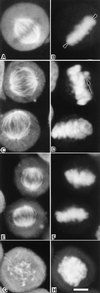Antiproliferative mechanism of action of cryptophycin-52: kinetic stabilization of microtubule dynamics by high-affinity binding to microtubule ends
- PMID: 9689077
- PMCID: PMC21335
- DOI: 10.1073/pnas.95.16.9313
Antiproliferative mechanism of action of cryptophycin-52: kinetic stabilization of microtubule dynamics by high-affinity binding to microtubule ends
Abstract
Cryptophycin-52 (LY355703) is a new synthetic member of the cryptophycin family of antimitotic antitumor agents that is currently undergoing clinical evaluation. At high concentrations (>/=10 times the IC50), cryptophycin-52 blocked HeLa cell proliferation at mitosis by depolymerizing spindle microtubules and disrupting chromosome organization. However, low concentrations of cryptophycin-52 inhibited cell proliferation at mitosis (IC50 = 11 pM) without significantly altering spindle microtubule mass or organization. Cryptophycin-52 appears to be the most potent suppressor of microtubule dynamics found thus far. It suppressed the dynamic instability behavior of individual microtubules in vitro (IC50 = 20 nM), reducing the rate and extent of shortening and growing without significantly reducing polymer mass or mean microtubule length. Using [3H]cryptophycin-52, we found that the compound bound to microtubule ends in vitro with high affinity (Kd, 47 nM, maximum of approximately 19.5 cryptophycin-52 molecules per microtubule). By analyzing the effects of cryptophycin-52 on dynamics in relation to its binding to microtubules, we determined that approximately 5-6 molecules of cryptophycin-52 bound to a microtubule were sufficient to decrease dynamicity by 50%. Cryptophycin-52 became concentrated in cells 730-fold, and the resulting intracellular cryptophycin-52 concentration was similar to that required to stabilize microtubule dynamics in vitro. The data suggest that cryptophycin-52 potently perturbs kinetic events at microtubule ends that are required for microtubule function during mitosis and that it acts by forming a reversible cryptophycin-52-tubulin stabilizing cap at microtubule ends.
Figures





Similar articles
-
Mechanism of action of the unusually potent microtubule inhibitor cryptophycin 1.Biochemistry. 1997 Oct 21;36(42):12948-53. doi: 10.1021/bi971302p. Biochemistry. 1997. PMID: 9335554
-
In vitro pharmacology of cryptophycin 52 (LY355703) in human tumor cell lines.Cancer Chemother Pharmacol. 1999;43(2):115-25. doi: 10.1007/s002800050871. Cancer Chemother Pharmacol. 1999. PMID: 9923816
-
In vitro effect of cryptophycin 52 on microtubule assembly and tubulin: molecular modeling of the mechanism of action of a new antimitotic drug.Biochemistry. 2001 Nov 13;40(45):13510-9. doi: 10.1021/bi010926z. Biochemistry. 2001. PMID: 11695898
-
Cryptophycins: a novel class of potent antimitotic antitumor depsipeptides.Curr Pharm Des. 2001 Sep;7(13):1259-76. doi: 10.2174/1381612013397474. Curr Pharm Des. 2001. PMID: 11472266 Review.
-
Modulation of microtubule dynamics by drugs: a paradigm for the actions of cellular regulators.Cell Struct Funct. 1999 Oct;24(5):329-35. doi: 10.1247/csf.24.329. Cell Struct Funct. 1999. PMID: 15216890 Review.
Cited by
-
Progress in the discovery and development of anticancer agents from marine cyanobacteria.Nat Prod Rep. 2025 Feb 19;42(2):208-256. doi: 10.1039/d4np00019f. Nat Prod Rep. 2025. PMID: 39620500 Free PMC article. Review.
-
An antitubulin agent BCFMT inhibits proliferation of cancer cells and induces cell death by inhibiting microtubule dynamics.PLoS One. 2012;7(8):e44311. doi: 10.1371/journal.pone.0044311. Epub 2012 Aug 31. PLoS One. 2012. PMID: 22952952 Free PMC article.
-
Taxol suppresses dynamics of individual microtubules in living human tumor cells.Mol Biol Cell. 1999 Apr;10(4):947-59. doi: 10.1091/mbc.10.4.947. Mol Biol Cell. 1999. PMID: 10198049 Free PMC article.
-
Natural Cyclopeptides as Anticancer Agents in the Last 20 Years.Int J Mol Sci. 2021 Apr 12;22(8):3973. doi: 10.3390/ijms22083973. Int J Mol Sci. 2021. PMID: 33921480 Free PMC article. Review.
-
Antimicrotubular drugs binding to vinca domain of tubulin.Mol Cell Biochem. 2003 Nov;253(1-2):41-7. doi: 10.1023/a:1026045100219. Mol Cell Biochem. 2003. PMID: 14619954 Review.
References
-
- Wilson L, Jordan M A. Chem Biol. 1995;2:569–573. - PubMed
-
- Wilson L, Jordan M A. In: Microtubules. Hyams J S, Lloyd C W, editors. New York: Wiley; 1994. pp. 59–83.
-
- Hamel E. In: Microtubule Proteins. Avila J, editor. Boca Raton, FL: CRC; 1990. pp. 89–191.
-
- Jordan M A, Thrower D, Wilson L. Cancer Res. 1991;51:2212–2222. - PubMed
-
- Jordan M A, Thrower D, Wilson L. J Cell Sci. 1992;102:401–416. - PubMed
Publication types
MeSH terms
Substances
Grants and funding
LinkOut - more resources
Full Text Sources
Other Literature Sources
Miscellaneous

